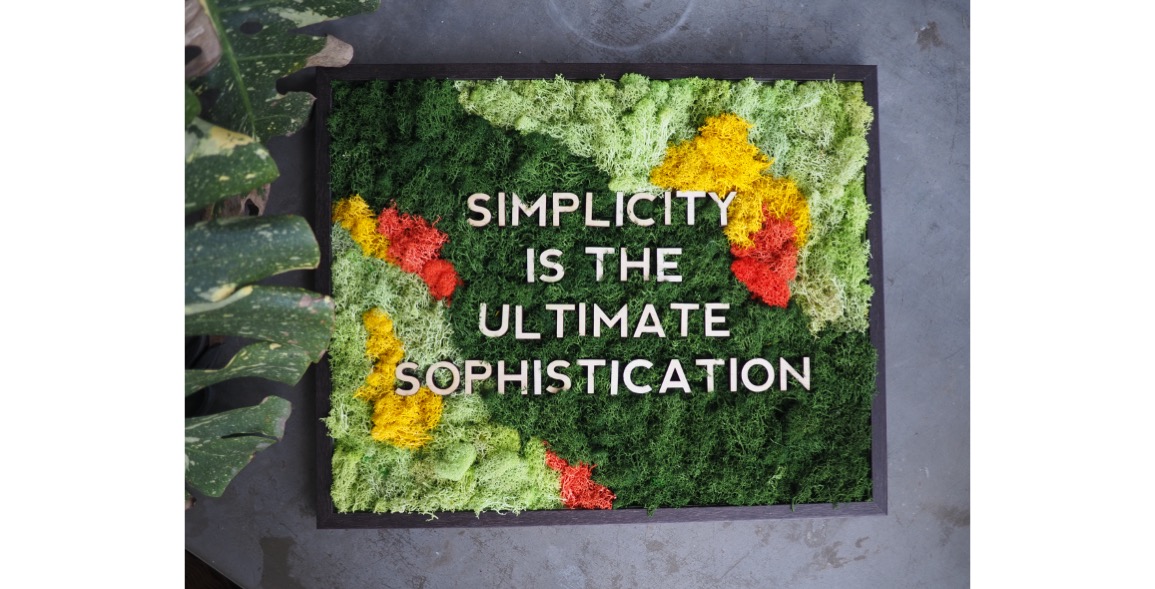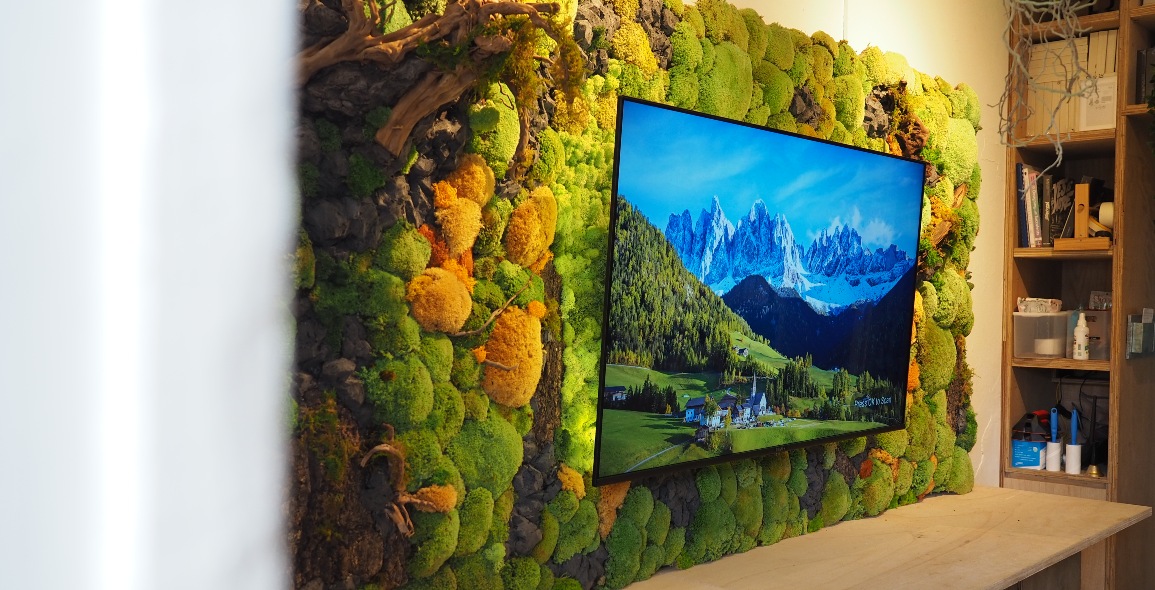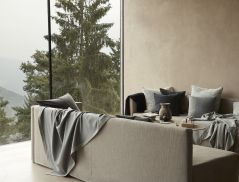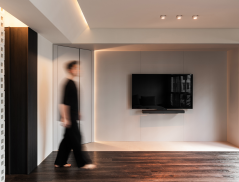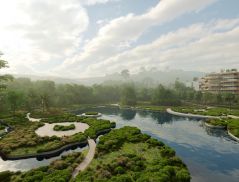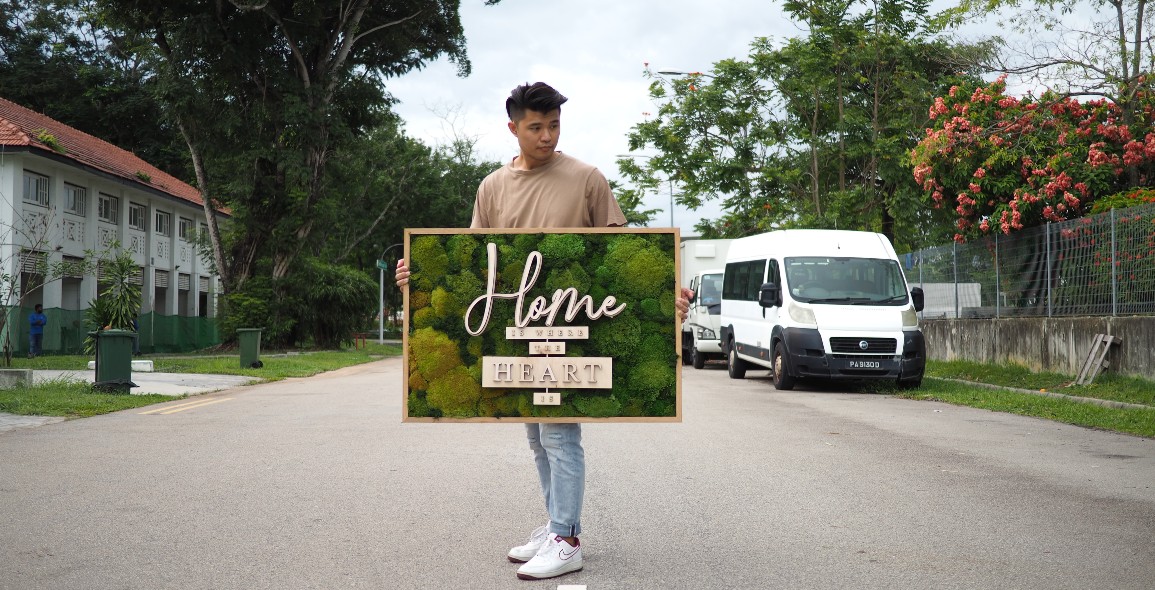
You hold a Master’s degree and spent two years working in the architecture industry. What was it about botanical art that distracted you enough to leave the industry and start InOut Atelier?
I grew up with twin interests in architecture and plants. I was mostly influenced by my father, who surrounded himself and our home with plants and pets. InOut Atelier actually started the year I enrolled into the National University of Singapore’s (NUS) School of Design and Environment – Architecture in 2014. The business was a pet project with a bunch of friends, where we decided to pool our interests to craft and sell terrariums at flea markets and pop-up stores.
Throughout my four years in NUS, I juggled school and managing the business, and eventually graduated with a Master's degree in Architecture. I was part of the Building and Construction Authority sponsorship programme, where I worked in the architecture industry for two years to serve my bond. But I soon realised that work had stripped away time from what I truly enjoyed doing, or rather, what I felt was my calling.
I decided to take a leap of faith to focus on InOut Atelier full-time. This move was driven by an entrepreneurial spirit that was fuelled by my love for nature, and also a growing understanding of biophilic design, which I developed during my undergraduate years.
I came to understand that all humans have an innate and genetic affinity with the natural world. We subconsciously choose to be closer to nature because it helps us relax, improve our mental well-being and increase productivity. The more I researched, the more I became convinced about InOut Atelier’s vision as a bridge between the indoor and outdoor space, through botanical art and design, while at the same time, improving overall wellness.
I also realised that there is a lack of understanding and awareness about biophilic design, and the health and economic benefits it brings about among the general public. I envisioned InOut Atelier to fill that gap. We advocate biophilic design through our terrarium and preserved moss frame workshops, and our botanical products as a medium for low-maintenance greenery.
How do you come up with your mosstallation and terrarium designs?
Nature will always be my main source of inspiration. I like to observe how the softscape grows and triumphs the hardscape over time. It is fascinating to observe how vegetation grows into a picturesque landscape from a macro lens; and if we were to zoom in, observing patches of vegetation coming together to form a composition through colour, texture and climate is intriguing as well.
The materials I have on hand also determine my designs. For a terrarium project, I use rocks, pebbles, gravel and sand to represent the hardscape. And since nature shows us that the hardscape will always exist before the wild vegetation takes over, the foundation of the terrarium landscape is laid first. Using bigger rocks, I play with shape, hierarchy and juxtaposition to lay the foundation. Live mosses come in as the softscape and are carefully inserted within and around the hardscape. It’s an organic process, just as how nature behaves.
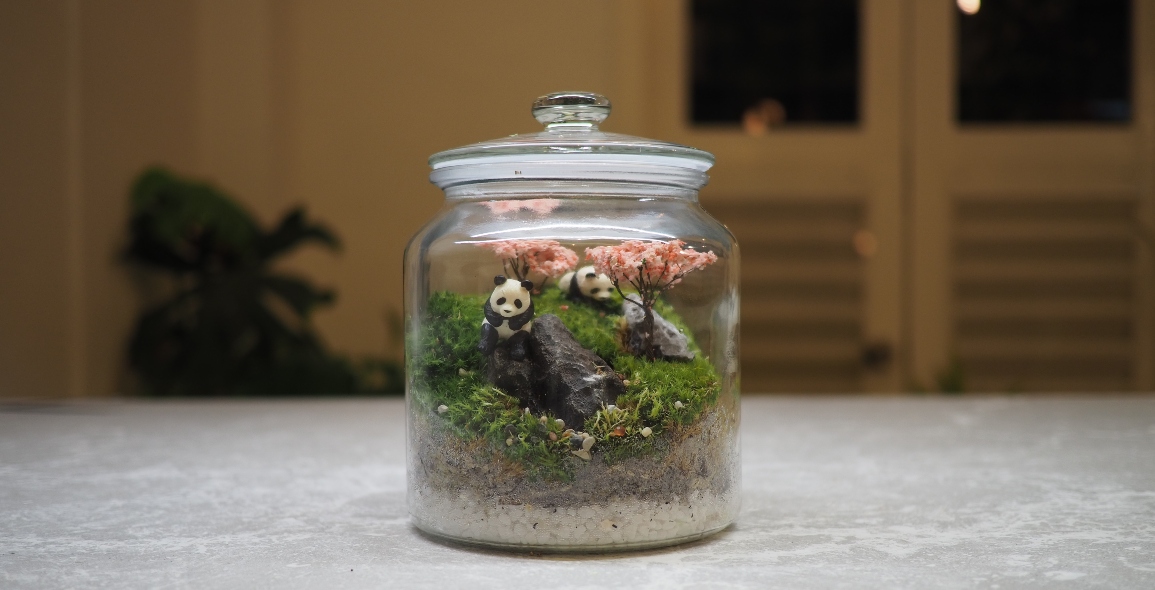
For mosstallations, I visualise how the topography and hardscape elements, such as drift wood or rock foam, come together to form the overall design. The softscape is laid with scale, proportion, colours and contrast of the individual preserve mosses in mind.
How do you think your degree in architecture helps in your creative work at InOut?
It helps in the way that I look at aesthetics, functionality, scale and proportion, just to name a few. But the most poignant lesson was when my lecturer taught me to look at the space I’ve curated and created through the lens of the human figurine placed in my architecture model, exploring the spaces from the inside-out. And then taking a few steps back to look at the model from the outside-in.
This enabled a deeper appreciation of space, which I adopted in the building of my terrariums. I always visualise myself as a figurine exploring the terrarium landscape and use my experience of the space to shape the scale and proportion.
Another major takeaway from school was how form follows function. Understanding the needs of my clients and the usage of the design is equally, if not more, important than the aesthetics of our products.
As we deal with botanical art, aesthetics play a very big role in the final design, but I believe that the purpose of the products gives them their value. It could be a mosstallation project that acts as a feature wall to soften the space, or one that is designed as an acoustic barrier in a sound-sensitive room. Regardless of the scale of our projects, there’s a need to view the space holistically and visualise how the product will interact with other interior elements in order to create beautiful and meaning work.
What would you say to people who are sceptical about what you’re offering at InOut and the advantages of biophilic design?
There are occasions when I see biophilic terms being misrepresented or misconstrued. That is why I try my best to share about the concept whenever the opportunity arises.
To those who have not heard or do not understand what biophilic design is, I usually start by conducting a mini experiment with them. I will ask them to close their eyes and visualise themselves in a place that makes that relaxed, happy and stress-free. I will ask them to describe the place to me. More often than not, the place they describe usually involves scenery overlooking a waterbody with greenery and fresh air, or looking up at the night sky filled with stars, or looking at the ocean against the horizon. There is usually an element of nature in their happy place.
This is biophilia at work. According to a paper by Terrapin Bright Green LLC, humans are innately biophilic, and “holds a biological need for connection with nature on a physical, mental and social level. This connection then affects our personal well-being, productivity and societal relationship”. Whether it is interacting with nature through a stroll in a park, enjoying the sound of birds chirping, or simply having a view of greenery from one’s home or workplace, biophilia has many applications that help transform mundane settings into stimulating environments that benefit us in more ways than we can imagine.
Not many people know of the many applications of biophilic design we can apply to our indoor settings. These include having a view of the outdoors, allowing natural daylight to flush in, or simply having some natural stimuli indoors. The mosstallations and terrariums by InOut Atelier are just some of the many biophilic applications out there. We are merely scratching the surface of what biophilic design encompasses, as there is so much potential to reap its full benefits.


What would you say to architects and interior designers to convince them to work with you in their projects?
I believe that biophilic design is a way of life and working with architects, interior designers and artists can the push boundaries of what it can do.
Plants are conventionally used as a way to soften the space and bring comfort to people. They usually come in as an afterthought, or rather, a “cosmetic” feature in the space. There is no real marriage between the two. This is a phenomenon that remains prevalent in the industry. The work that I do at InOut Atelier is to bridge the gap between the indoors and out, through design that enhances people’s lives. Working with professionals in the industry will enable us to explore even more applications of biophilic design for different types of spaces.
Biophilic design is not a trend and should be incorporated in our daily lives. More homeowners and companies are exploring this aspect as mental well-being is becoming increasingly looked into. I believe that there is a lot of potential out there to transform our living and workspaces.
You devised a process of preservation of the live pole moss. Can you share a bit more about what this is?
We procure live moss from Northwestern Europe and leave them alone to dry before we start preserving them. The drying process may take a few weeks, depending on the weather, so the duration is not entirely up to our control.
Once they are ready, we proceed to preserve them manually, one by one. This is usually the most onerous step and a crucial one because it determines how the preserved moss will turn out, so they have to be done meticulously to ensure quality control. Next, they have to be left alone for weeks to dry and to allow the preservative solution to soak and be absorbed into the moss. The result is preserved pole moss that are soft to the touch and also kept vibrant and life-like.
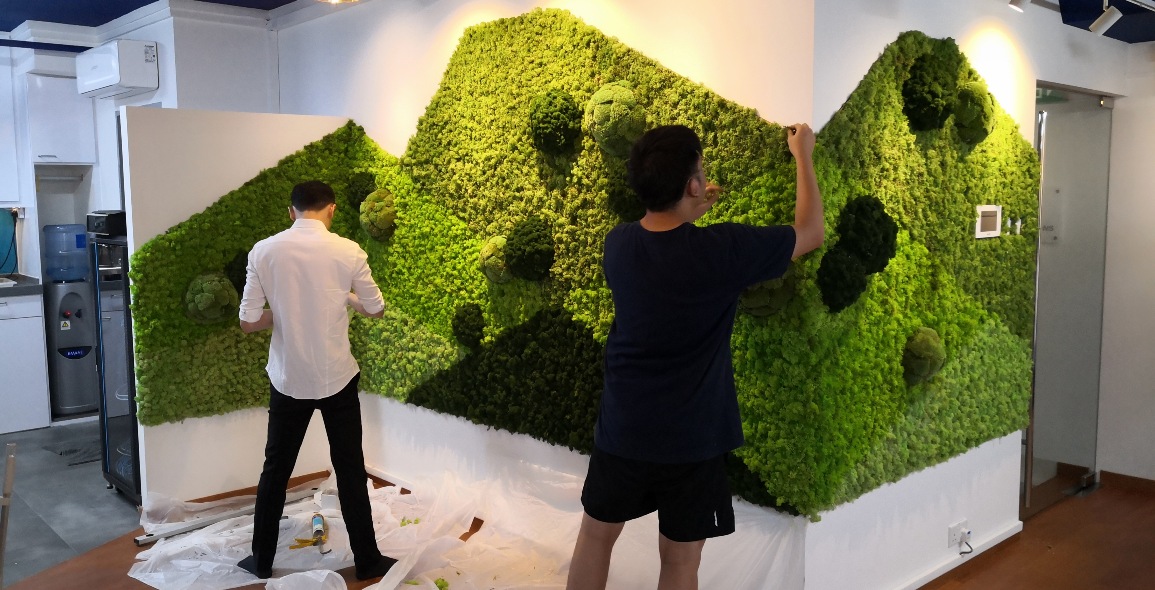
You’re clearly passionate about biophilic design. Please share how beneficial it is to humans.
The benefits of biophilic design are not immediate and in many cases, unmeasurable. As a result, they are often overlooked and not taken seriously. That is why we take pride in ensuring that our mosstallations and terrariums are done with tact and aesthetics in mind. At the very least, a positive impression will be imprinted on the user in the space.
One of our clients who commissioned a mosstallation for her new office commented that its vibrancy not only brings a liveliness to her workplace, it also left a strong impact on the clients who visited her office. It set her apart from her competitors by demonstrating the company’s interest in the environment and sustainability and left a positive impression of the brand on her clients.
There are numerous economic benefits to incorporating biophilic design in a workplace as it increases employees’ productivity and reduces absenteeism. All business owners know that labour is the highest cost of running a business and a poor-performing workforce is highly detrimental.
It makes commercial sense to include biophilic elements in the workspace, which enhances the mental well-being of employees. The results will be reflected in the business outcome in the long run.
The use of plants and greenery is the most common and direct approach. However, we understand that not all indoor spaces are suitable for growing plants, due to the lack of natural lighting and humidity (for some plants). Our mosstallations, which require zero maintenance, serve as part of the solution for biophilic needs.
How has your life changed since starting InOut?
I have always enjoyed handicraft and creating objects by hand. I derive a lot of contentment in being caught up in the design process and materialising my ideas. But I found this was a rare luxury while working in the architecture industry, as we were always working on tight deadlines with constant revisions needed. This resulted in long working hours and an emphasis on executing deliverables, which left little room for ideation. Nevertheless, I enjoyed my time there and learned a lot through dedication and commitment to my projects.
After leaving the architecture industry to pursue my passion through InOut Atelier, I have become an artist, a designer, an advocate and most importantly, a business owner. I am made to wear different hats when the situation calls for it and this has allowed me to grow in ways that I could not have imagined, both as a person and as the co-founder and art director at InOut Atelier.
I believe that there is some truth to the saying “love what you do, and you'll never work a day in your life”. We spend most of our lives working and for me, the only way to be truly satisfied and accomplished is to do what we believe is great work. And to be able to do great work, we must first love the work that we do.


 Share
Share
